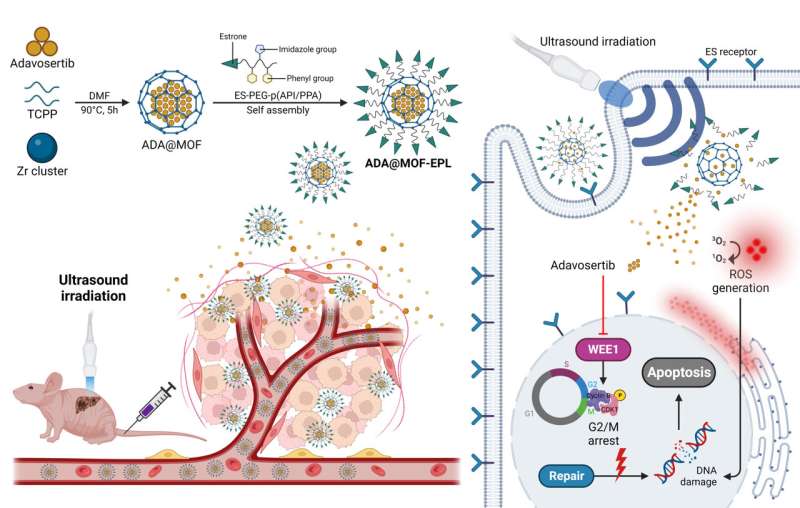This article has been reviewed according to Science X's editorial process and policies. Editors have highlighted the following attributes while ensuring the content's credibility:
fact-checked
trusted source
proofread
Using adavosertib-encapsulated MOFs for p53-mutated gallbladder cancer treatment via synthetic lethality

Since the revelation of poly(ADP-ribose) polymerase (PARP) inhibitors and their remarkable results in the treatment of BRCA1/2 mutant cancers, synthetic lethality (SL) in antitumor therapy has attracted increasing attention. SL is a phenomenon in which a single genetic event is insufficient to induce cell death, but multiple genetic events lead to cell death.
The characterization of SL genetic interactions with tumor-specific mutations can be used to develop a conceptual framework for tackling "undruggable" targets such as tumor suppressor gene p53. Gallbladder cancer (GBC) is the most prevalent malignant tumor of the biliary system and is typically fatal due to the limited efficacy of existing treatment.
It has been reported that p53 is one of the most frequently mutated genes and a poor prognostic marker in GBC. Therefore, an SL-based strategy for targeting p53-mutated GBC is a promising approach.
A new study on this topic led by Prof. Mingyu Chen, Prof. Xiujun Cai, Dr. Shjie Li, Dr. Sarun Juengpanich and Dr. Win Topatana, all of Sir Run-Run Shaw Hospital, Zhejiang University, and Prof. Jicheng Yu of the College of Pharmaceutical Sciences, Zhejiang University appears in Science Bulletin.
Previous studies have shown that DNA damage repair achieved by WEE1 through the regulation of cell cycle G2 checkpoint is essential for the survival of p53-mutated cells. Therefore, adavosertib (ADA), a WEE1 inhibitor, has a significant synthetic lethal effect on p53-mutated cancers. However, drug resistance due to DNA damage response (DDR) compensation pathways and high toxicity limits further applications.
Recent studies have indicated that the use of physical factors such as photodynamic therapy (PDT), sonodynamic therapy (SDT), and gas therapy in the treatment of tumors has superior effects and a broader range of applications than conventional chemical drugs. Physical factors provide irreversible conditions to enhance the synthetic lethal effect of tumor-killing will prove to be an effective strategy.
Thus, based on the capability of MOF structure to realize various additional conditions while delivering drugs, this new study selected MOF as a tool in conjunction with SDT to enhance the synthetic lethal effect between WEE1 and p53 in GBC and obtained a promising result.
Specifically, a sonosensitive porphyrin (tetrakis (4-carboxyphenyl) porphyrin, TCPP)-containing Zr-MOF was used as the organic backbone for sonodynamic therapy (SDT), followed by ADA encapsulation during the one-pot MOF synthesis to increase the ADA loading of MOFs (ADA@MOF). Furthermore, the surface of ADA@MOF was coated with pH-responsive estrone-targeted polymeric ligands (EPLs) to provide the nanoparticles with a tumor-targeting ability (ADA@MOF-EPL).
Due to the high expression of estrogen receptor (ER) in GBC, estrone functions as a tumor-targeting ligand, allowing nanoparticles to rapidly and accurately enter and accumulate near the cell nucleus. Upon entering the acidic tumor microenvironment (TME), the weakened ionic interactions between ADA@MOF and EPL will loosen its structure, leading to the initial release of ADA.
Subsequently, ultrasound (US) irradiation to stimulate the sonosensitive porphyrin-containing MOF will result in the accelerated release of ADA and generate ROS for damaging DNA. This will cause a higher sensitivity of p53-mutated cancer cells to ADA and avoid drug resistance due to DDR compensation pathways at the source.
Thus, the enhanced synthetic lethal effect between ADA and p53 through an additional condition of SDT would have a robust tumor-killing ability. In addition, the nanoparticles also greatly reduce the toxic reaction of the drug. Most importantly, this new study offers a novel perspective on the use of MOF-based drug delivery systems in the treatment of various refractory cancers via enhanced SL.
More information: Shijie Li et al, Adavosertib-Encapsulated Metal-Organic Frameworks for p53-Mutated Gallbladder Cancer Treatment via Synthetic Lethality, Science Bulletin (2024). DOI: 10.1016/j.scib.2024.02.039
Provided by Science China Press





















